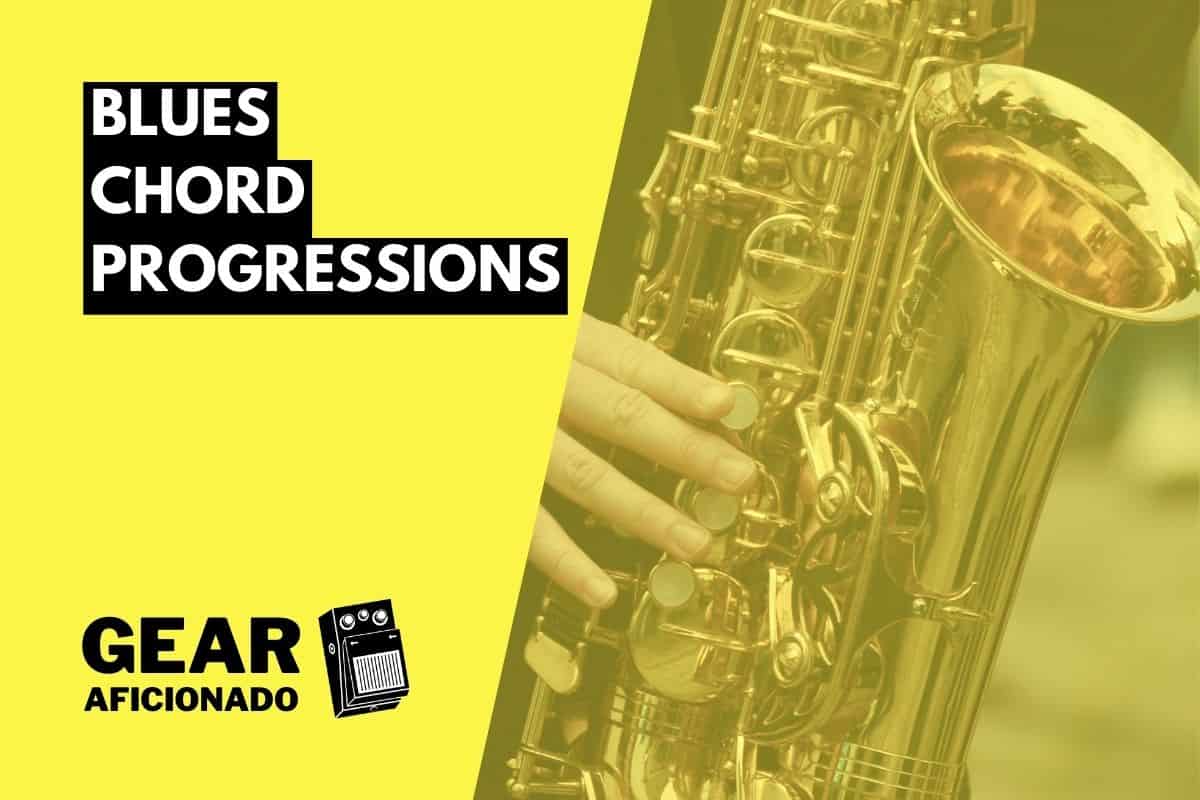Very few musical styles can soothe your senses, make you dance, be your company on sad days, and fill your heart like the Blues.
Yes, this genre has exceeded all the lines that once marked its borders and has flooded the world with amazing songs that drive crowds crazy every year.
I know what you’re thinking, I was there once too: “Where do I begin to learn the Blues?”
This question is far too common, and the internet is far too flooded with resources that will mesmerize you.
Yet, you’ve come to the right place because we’re covering the most amazing 11 Blues chord progressions and chord variations to help you master the blues in no time.
Blue is about to be your new favorite color; are you in?
The Blues Chords
Dyeing a composition blue isn’t such an easy job.
Indeed, you might think that a hat, an archtop guitar, and a blue suit or dress will make you a righteous blues player but it’s a little more complicated than that.
Yes, the blues is all about expressing your deepest feelings and connecting with other players and the audience.
But never forget that, while melody and lyrics tell a story, chords tell another one. Moreover, the story told by the chords supports everything else.
Therefore, picking the right chords to play the simple blues progressions can unlock a whole new sonic universe for your guitar.
Since you’re in the right place at the right time, we’ll unlock that Pandora box and you’ll get to know a couple of handfuls of new chords that can help you better convey your feelings besides making a more interesting base for the melody and lyrics to shine.
Let’s see some alternate positions for chords you surely already know and some groundbreaking new chords for you to enjoy.
Let’s Talk about Minors and Sevenths
The Blues is called that way for a reason, and that reason screams for minor chords!
Yes, while major chords are happy and fulfilling, minor chords are always textured and kind of sad, conveying that blue element any blues song needs.
But how do we transform a major chord into a minor chord? Well, both: major and minor chords are triads. This means they are made of three notes.
Major chords are made by stacking up the root note of the scale (I), the third (III), and the fifth (V).
For example, C major is C – E – G. C is the root note, E is the third, and G is the fifth.
| C | E | G |
| 1 | 3 | 5 |

If we want that chord to become a minor chord, we simply move the third one semi-tone lower.
| C | Eb | G |
| 1 | b3 | 5 |
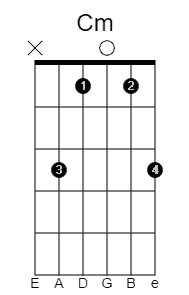
So, every time you need to find the minor alternative to a known chord, make sure you lower that third by half-a-tone.
I’m getting a little ahead with this, but what about progressions that use entirely major chords such as the 12-bar blues, for example?
Yes, when playing the utterly famous 12-bar blues, you need to play the I, IV, and V degrees of the scale.
If the scale is major, those degrees are all major chords.
But how do we turn these chords into blues-friendly chords? Well, we add a magic note; the seventh note.
Yes, we just saw that minor and major chords are triads. But we have four fingers to use in our fretting hand.
What if we could add one more note to the triad? Well, that’s exactly what we’re about to do to turn regular chords into seventh chords.
Maj7 Chords
The note we need to add for a seventh chord is, of course, the seventh degree from the same scale. These are the notes we need to use to form our chord, CMaj7:
| C | E | G | B |
| 1 | 3 | 5 | 7 |

Minor 7 Chords
But wait, because we can add even more flavor to this preparation by creating a chord that contains the sadness of the minor and the bluesy thing coming from the seventh.
Yes, since a seventh chord is a triad with an added note, if the triad is minor, the seventh chord is minor too.
These are the notes for the C minor seventh (Cm7) chord.
| C | Eb | G | B |
| 1 | b3 | 5 | 7 |

Dominant… or Just 7 Chords
When you see a chord written down with only a seven next to the letter, that means that you’re in the presence of a dominant seventh chord.
What’s the particularity that makes these seventh chords so famous? Well, they bring in the dominant element to the mix making the chord the perfect pivot to go back to the root or I chord in your progression.
How do we make a dominant seventh chord? Well, we need to lower the seventh by half a tone.
Let’s see what our C7 looks like:
| C | E | G | Bb |
| 1 | 3 | 5 | b7 |

Let’s Add More Flavors!
Now that we’ve seen the minor, the minor seventh, dominant seventh, and major seventh chords, it’s time to add some other flavors to the blue mix.
I promise that, regardless of how many 9th or 13th chords you include, the result will always be the same color: blue.
Ninth Chords
Remember that, when we were constructing our seventh chords, we added the seventh grade of the scale to our triad.
Well, to form a ninth chord, we need to add the ninth note to the triad.
I know what you’re thinking: the scale only has seven notes! Well, we’re starting over our count and going up to nine.
How did blues players get to know the ninth chords? Well, after the musical style exceeded the boundaries of the delta and reached Chicago, the players wanted to give their compositions a more sophisticated city flavor.
Therefore, instead of just using the 7th chords, they also started using the 9th chords.
Again, since it’s a note added to a triad, it can be a minor ninth (m9), major ninth (Maj9), or dominant ninth (9).
Let’s take our C chord to make the three forms of the ninth chord as an example. You’ll notice that we’re removing the fifth and adding the seventh.
This gives the chords you’re about to see a much more bluesy flavor.
CMaj9
| C | E | B | 9 |
| 1 | 3 | 7 | D |
Cm9
| C | Eb | B | 9 |
| 1 | b3 | 7 | D |
C9
| C | E | Bb | 9 |
| 1 | 3 | b7 | D |
These are just one of the possibilities you can use on your fretboard for these chords:
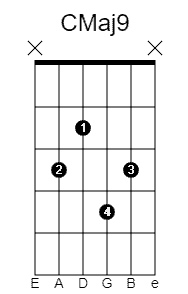
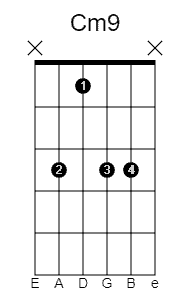

Thirteenth Chords
Adding ninth chords to your typical progression is something players like Robben Ford would be proud of.
Now, adding thirteenth chords is something that Robben Ford would comment on and congratulate personally after the show is over.
Yes, the very thin red line dividing jazz and blues can be a little blurry here, but with the right setting and accompaniment, you’ll be sounding like a sophisticated, cool, knowledgeable blues player to the rest of the people in the room (and on the stage).
Furthermore, you’ll achieve that without much effort.
Again, instead of using our fifth note, we’ll skip it and add the seventh and the thirteenth to make it sound more bluesy.
Why don’t we take out the third, you might be asking.
Well, the answer is very simple, the third is what gives a chord its major or minor quality; therefore, it stays.
Let’s see what our C chord looks like when it transforms into CMaj13, Cm13, and C13.
CMaj13
| C | E | B | 13 |
| 1 | 3 | 7 | G |
Cm13
| C | Eb | B | 13 |
| 1 | b3 | 7 | G |
C13
| C | E | Bb | 13 |
| 1 | 3 | b7 | G |
These are just some of the shapes you can construct using the notes for each chord.
Remember that the entire fretboard is your canvas, and these are your colors, so feel free to arrange them however is more convenient for you.
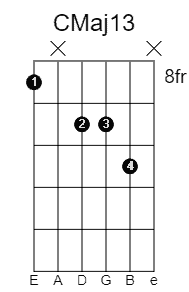
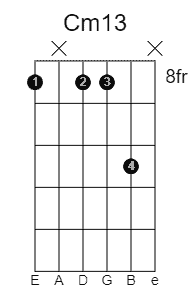
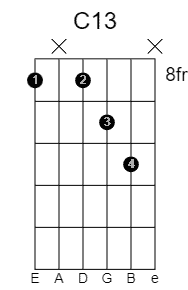
Finally, before going to our progressions; feel free to transform any chord you want in any of the progressions into a seventh, ninth, or thirteenth chord.
Make sure you always respect the major or minor quality of the original chord (lower case means minor, upper case means major).
11 Amazing Blues Chord Progressions
1. 12-Bar Blues (I – I – I – I – IV – IV – I – I – V – V – I – I)
2. I – vi – IV – V
3. vi – ii – vi – IV – III7
4. vi – IV – I
5. I – ii
6. V – IV – I
7. vi – I – II7
8. vi – IV – V
9. VI – I – II
10. i7 – iv7 – i7 – bVI7 – V7 – i7
11. I – V – IV – IV – I – V – I – V
The Bottom Line
The blues depicts the beauty of simplicity and aims at making you feel something.
These are all the tools you need to get started on that blue path to guitar mastery.
Use the information here to practice and soon, you’ll be painting the world blue.
Happy (blues) playing!

Hello there, my name is Ramiro and I’ve been playing guitar for almost 20 years. I’m obsessed with everything gear-related and I thought it might be worth sharing it. From guitars, pedals, amps, and synths to studio gear and production tips, I hope you find what I post here useful, and I’ll try my best to keep it entertaining also.

